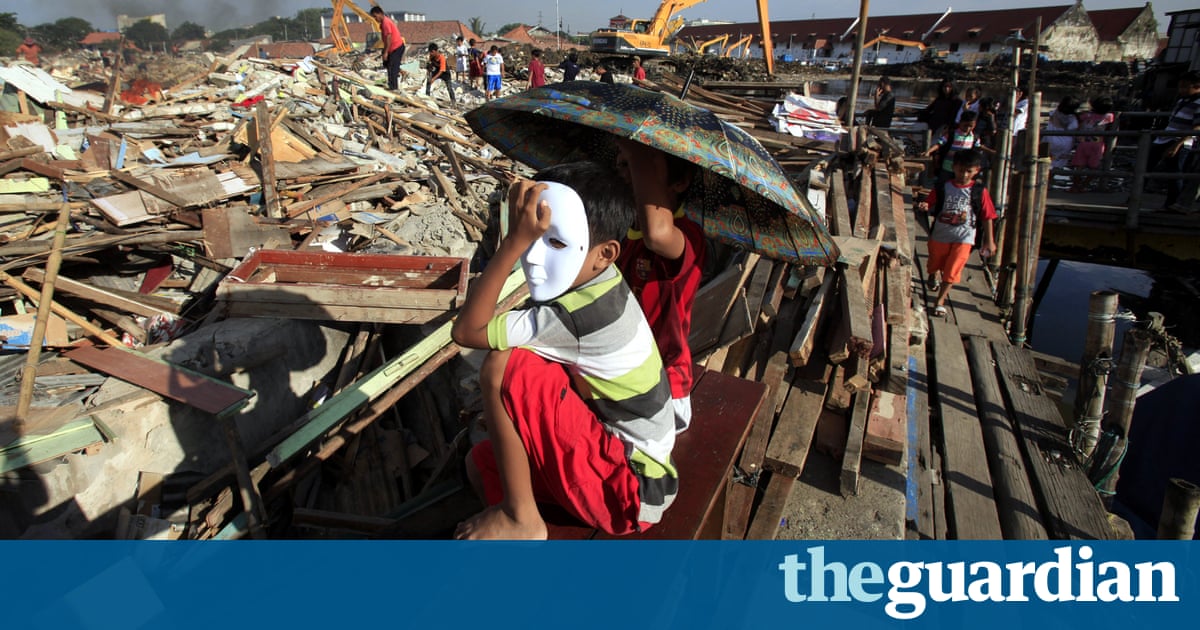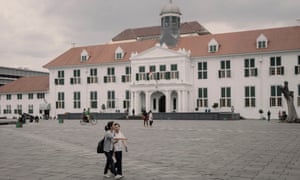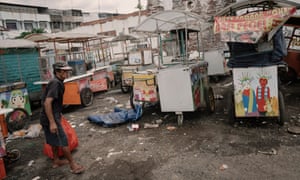‘Get off the square!’: The unsubtle gentrification of Jakarta’s old town

Fatahillah Square was once a bustling hub of culture and nightlife. Now street vendors are forcibly removed, and hundreds of homes have been demolished in order to build corporate plazas. Has the area lost its soul?

Get off the square! the security guard yells into his megaphone. The place is going to be cleaned!
Its 10pm on Friday night in Fatahillah Square in the heart of Kota Tua, Jakartas old town, and the public are being herded out. Uniformed city workers take their place, sweeping up trash from the 1,300 sq metre pedestrianised area in the shadow of the Jakarta History Museum, formerly colonial city hall.
After 10pm, people werent coming for tourism, says Norviadi Setio Husodo, head of the Old Town Zone Management Unit, explaining the decision to limit visiting hours to what is ostensibly a public space. They came to make out in dark corners. We saw lesbians, homosexuals. We saw people getting drunk in the square. Garbage was piling up. Now we see much less garbage.
For decades, Jakarta has wanted to revitalise the old town, the centre of old Batavia, which once bustled with life and trade under the colonial Dutch administration. The effort has seen its ups and downs, but in the past two years has gathered steam, with a bid for the area to become a Unesco world heritage site and the city preparing to host the 18th Asian Games in 2018.
In particular, the city has attempted to woo private investors. Buildings have been renovated, there are plans to make over the black and putrid river, upscale tenants are being encouraged to open up shops and security has been beefed up.

For the undesirables who currently live and work here, however, there is no such love. Street vendors and artists have been largely barred from the square. In April, the city demolished the homes of 400 families who had lived in Pasar Ikan for decades to make way for a food court, a plaza and a souvenir centre. In Jakartas old town, development comes with a price and the city administration gets to decide who stays and who leaves.
In order to prevent what he calls negative things that are not specifically for tourism, Husodos team has, as well as limiting visiting hours, hired 73 men to guard the seven entrance points to the square. They work 24 hours a day, seven days a week. And where there were once two cleaners, there are now 35.
The desire to revitalise the old town which spans more than 300 hectares from Chinatown in the south to Sunda Kelapa harbour in the north is not new.
In recent decades, however, the area became notorious for bad traffic and disreputable nightclubs. The distinct Dutch colonial architecture had begun to decay, as owners found it too expensive to renovate in compliance with heritage building regulations. As the buildings deteriorated, the seedy karaoke lounges, clubs and prostitutes moved in. Investment fled south, into Jakartas golden triangle: the streets that enclose the central business district.
So in 2007, the city renovated the square, making it a pedestrian area and encouraging museums and historical societies to hold events. It was a huge success. Fatahillah Square became a popular free gathering area for people from all walks of life, especially precious in a city with very little public space. Most of its visitors were from middle to low-income brackets, arriving via the Transjakarta BRT bus, commuter trains or motorbikes.

With its increasing popularity came the informal economy. Street vendors packed the square, sharing space with pedestrians, selling food, drinks, T-shirts, bags, shoes and accessories, and relying on busy foot traffic for sales. Mascots posed with tourists for pictures; performers wearing elaborate historical costumes acted as statues; there were street buskers, toy hawkers, traditional travelling performers, men carrying exotic snakes, reggae bands, pickpockets and a Dutch-style bicycle rental service.
With the square bursting at the seams, the historical and museum societies complained they were being sidelined. Three museums surround the square the Jakarta History Museum, the Puppet Museum and the Art and Ceramics Museum and they did not enjoy as much popularity as the square itself.
In 2013, the city invited in the corporate world. The Jakarta Old Town Revitalisation Corporation (JOTRC) is a consortium of nine companies, among them property giants, who each gave $1m considered a donation or corporate social responsibility to renovate more than a dozen buildings in cooperation with the owners, mostly state-owned companies. Once the JOTRC finished renovating a building, it would get a 20-year lease from the owner and rent the space to a retail tenant clothing chains or restaurants at a lower rate than Jakartas upscale shopping malls.

We want this to become a creative and tourism city. We want this place to be built by young people, we want co-working spaces and a marketplace for young people to develop a creative place, says Andy Budiman, a JOTRC spokesman. We will have museums, performing art halls, like in European old town areas.
Profit was not the companies aim, Budiman says. Rather, they want a sustainable development of the area, and to expand the market to include upper-income visitors as well.
The city administration had its own plans, too. The ambition of Jakarta governor Basuki Ahok Tjahaja Purnama was to create Jakartas very own Cheonggyecheon the modern public park built along what was once a clogged and filthy river in Seoul, South Korea. Renowned architect Budi Lim was hired to turn 600 metres of Jakartas foul-smelling waterway Kali Krukut into a water tourism space, by filtering and cleaning polluted wastewater that is dumped into the river by houses upstream. The project cost Rp 270bn (16m), which was provided by the building corporation Sampoerna in exchange for permission to add more floors to their towers in central Jakarta.

In September this year, the city sterilised the square, prohibiting street hawkers and performers, but allowing bicycle rentals, statue performers and street painters to stay. They have something to do with art and culture, and the bicycles and statue performers are an iconic part of the old town, says Taofik, the head of the security detail.
Some visitors like it better this way. Teenagers still congregate here to eat instant noodles and drink orange juice. Others think the square has turned into a boring, sterile place.
Before, there were street performers, pantomimes, pencak silat [traditional martial arts], says Andrew Kansil, a 25-year-old auditor and amateur photographer who used to visit Fatahillah Square regularly to take pictures. They were creative people. Every time, there was something new. There was a good dayak dance and music group, there was cosplay. We didnt go there only to stare at the buildings.

The street vendors roughly 400 of them were relocated to a nearby empty lot in a swampy area that is mainly used for parking rubbish trucks: a place that few people have a good reason to visit. The vendors say there were left there to die.
Murni, 43, is lying on her piles of plush animals. In the past, she says, most of her sales came after 10 pm, when the girls working in nightclubs bought her stuffed bears. Since being relocated here two months ago, however, trade has plummeted. I hardly sell anything here. Now, no one comes here. Before I could earn up to Rp 1m (61) a night. Here, getting Rp 50,000 is already good.
To the authorities, the nightlife that once unfolded here after dark was negative and immoral. But for the street vendors, the revelers were customers. Aking, a corn seller in his 40s, says that over the past three years the old town was more bustling at night than during the day. Although some people were drunk, the area felt safe.
There are new plans to expand the revitalisation to the harbour, by creating a sea-themed public space near the Maritime Museum in Pasar Ikan.
This is where the most hardheaded evictees hold their ground. On demolition day in April, residents clashed with more than 4,000 officials, police and soldiers who were sent to accompany the bulldozers. Some Pasar Ikan residents refused to move to social housing, which is more than 12 miles away from their homes, and have spent the last seven months living in makeshift tents and shacks on the rubble of their old houses. They have filed a lawsuit against the forced eviction in Central Jakarta district court.
Why cant we share the land? The city wants a plaza, fine, but share the space with us, says Dharma Diani, 40, a Pasar Ikan resident. She says she has paid taxes to the government for decades and finds it unfair she could not be part of the revitalisation. We have been part of the tourism here. They want to build beautiful things here, why dont you create something good from us, too?
Evi Mariani is the city editor at the Jakarta Post
Follow Guardian Cities on Twitter and Facebook and join the discussion
Read more: https://www.theguardian.com/cities/2016/nov/23/fata-square-unsubtle-gentrification-jakarta-old-town